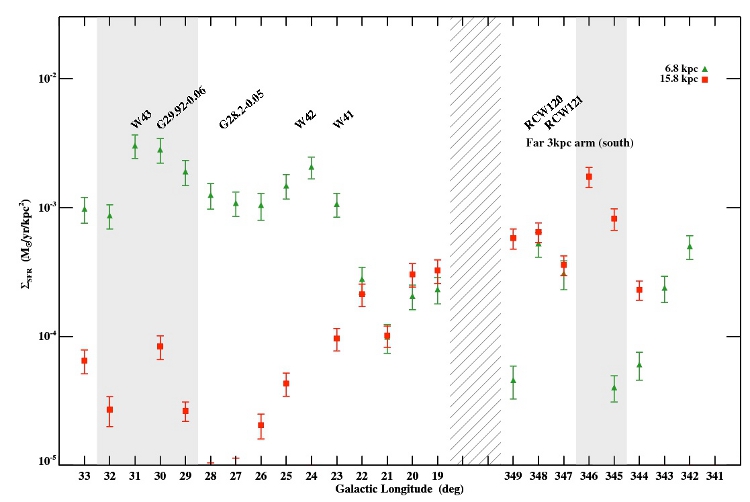| EPoS Contribution |
|
Star Formation at the tips of the Galactic Bar with Herschel/Hi-GAL
Marcella Veneziani IPAC/Caltech, Pasadena, CA, US | |
| We present the physical and evolutionary properties of the prestellar and protostellar clumps in the Hi-GAL areas, 19 < l < 33 deg and 340 < l < 350 deg, two deg wide, centered on the Galactic Plane and covering the tips of the long Galactic bar. Newly formed high mass stars and prestellar objects in these fields will be identified and their properties derived and compared. We can also identify five giant molecular complexes at the further edge of the long bar, identified through ancillary 12CO(1-0) data from the NANTEN observatory, and compare them with some sample region in the closest edge. The star formation rate has been estimated through a star counting method, applying the evolutionary model of collapse in turbulent cores. By means of a Monte Carlo analysis, we calculate the corrective factor with respect to the model, considering that our sources are mostly clumps, and not cores, which will likely collapse into star clusters and not in single stars. The goal of this analysis is to better study the Milky Way activity, by defining the role of the spiral arms in the star formation processes both at the edges of the bar and in the background and foreground regions. It is in fact still a matter of debate if the particular configuration of the galactic rotation and potential at the sides of the bar could trigger star formation. | |
 | |
| Caption: Star Formation rate surface density as a function of the Galactic longitude for two typical heliocentric distances. The shaded grey regions indicate the Galactic Center (dashed), and the edges of the bar (filled). Known star forming regions are also reported. | |
| Collaborators: M. Veneziani, IPAC, Caltech E. Schisano, IPAC, Caltech D. Elia, IAPS/IFSI A. Noriega-Crespo, Space Telescope Science Institute S. Molinari, IAPS/IFSI M. Pestalozzi, IAPS/IFSI |
Suggested Session:
Massive Star Formation and Feedback |

